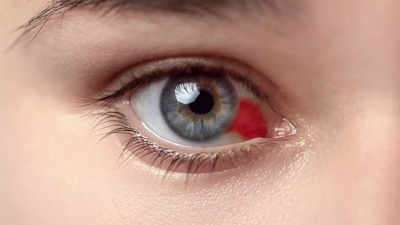Global reports of the fast spreading Marbug or bleeding eye virus has raised concern about the deadly disease which has already spread to some countries. Marburg is spread through contact with Egyptian rousette bats, or by contact with infected individuals. How safe are the people in India and what are the current treatment options available for viral disease. Full report.
As per the latest update a new strain of virus called the Marbug virus has sparked concerns globally. The disease which can be transmitted from human to human can cause fatal symptoms and lead to death in 50 percent of the cases. One of the typical symptoms of the disease is bleeding of the eyes and hence it has been termed as the bleeding eye disease. Marburg is spreading in multiple countries, according to the UK Department of Health’s site, Travel Health Pro. There have been 66 illnesses and 15 deaths in Rwanda, according to the CDC, but many more may be infected.

Urgent Marburg warning issued over spread of deadly ‘bleeding eyes’ virus
As per the data provided by the World Health Organisation (WHO) Marburg virus disease (MVD) which typically causes bleeding eye syndrome was earlier known as Marburg hemorrhagic fever. It presents itself in majority cases as a fatal illness in humans. The average mortality rate in the disease is around 50%. However this has varied in different outbreaks from 24% to 88%.
Symptoms of the disease
Marburg virus disease (MVD) also known as bleeding eye disease is caused by Marburg virus, a member of the filovirus family (the same family as the Ebola virus). Symptoms typically appear 2–21 days after exposure and last for several weeks.Dr. Neha Mishra, Consultant – Infectious Diseases, Manipal Hospital Old Airport Road says,
“ The disease can have 3 phases depending upon the timing of presentation, the “Generalization Phase”, which is characterized by flu-like symptoms and rash, an “Early Organ Phase”, which involves manifestations in specific organs, like encephalitis or hemorrhages, and a “Late Organ/Convalescence Phase”, which is characterized by multi-organ failure, shock, coma, and either death or recovery. Visiting places with ongoing outbreaks or visiting the bat caves may spread the Marburg virus. The medical units practice complete isolation of the patients and care for these patients with utter cautions to curtail the spread. This virus can impact the travel to the areas. However, with proper precaution and public awareness, the spread of the Marburg virus can be avoided.”
Early symptoms (Day 1–5)
Sudden onset of high fever with chills.
Severe headache with muscle aches and pains.
Extreme fatigue and weakness.
Loss of appetite.
Later symptoms (Day 5–7)
Nausea, vomiting, and diarrhea: Can become severe, often described as “watery diarrhea.”
Abdominal pain and cramping.
Sore throat.
Rash: A non-itchy rash may appear, primarily on the chest, back, and stomach.

Representative Image (Credits: canva)
Extreme symptoms
Bleeding from the gums, nose, or injection sites; blood in vomit, stool, or urine as the fever causes haemorrage.
Liver failure, kidney dysfunction, and jaundice.
Neurological symptoms due to brain involvement.
Septic shock due to severe fluid loss or bleeding.
In some patients it can lead to multi-organ failure, coma and death.
MVD spreads through contact with: Body fluids (e.g., blood, saliva, sweat, urine)
Infected surfaces or materials.
Infected animals, particularly bats and nonhuman primates.
According to Dr Harish Bhatia, Founder Director of Rebreathe Clinic, Senior Consultant Chest Specialist & Physician with Apollo Hospital, “There is no known vaccine or drug available and only symptomatic treatment is given to relieve symptoms. This includes intravenous drug infusion, blood transfusion, electrolyte management etc. Certain clinical trials are still underway on animal models that have shown success with monoclonal antibodies, but human trials are still ongoing. So as of now, the only focus should be on early detection and intervention at a good medical care facility.”
Dr Satya Prasad Balki, MBBS MS FCAS, consultant ophthalmologist & medical director, Truevision Eye Hospitals says, “The bleeding eye virus, which has now caused a global fear, can be a serious issue. If left untreated, it can lead to corneal damage and permanent vision loss. One may experience symptoms like redness in the eyes, pain or discomfort, swelling, bleeding from the eye surface. In severe cases, blood vessels may rupture. There is also a possibility of watery eyes, blurred vision, and sensitivity to light, along with fever, fatigue, and headache. One must avoid touching or rubbing eyes to prevent further irritation or spread. Washing hands frequently is important. It is advised to avoid contact lenses during the infection.”

Representative Image (Credits: canva)
It is noted that not every person infected with Marbug virus dies and so with timely treatment and diagnosis it can be managed as well and there are cases of recovery too. If Marburg virus is suspected, immediate isolation and contact tracing are critical, along with supportive care like rehydration and symptom management. No specific antiviral treatment exists, but early supportive care improves survival chances.
Origin of the disease
As per information provided by WHO. The viral infection was first detected in 1967 when two outbreaks simultaneously happened in Marburg and Frankfurt in Germany, and in Belgrade, Serbia. Like COVID-19 initially, this outbreak is also said to have its origin in the laboratory while working with African green monkeys (Cercopithecus aethiops) imported from Uganda. Since then occasional cases have been reported year after year in countries like Angola, the Democratic Republic of the Congo, Equatorial Guinea, Ghana, Guinea, Kenya, Rwanda, South Africa (in a person with recent travel history to Zimbabwe), Tanzania and Uganda.
As per data, the initial Marbug human infections were the result of prolonged exposure to mines or caves inhabited by Rousettus fruit bat colonies. But once transmitted to the human population, Marburg virus can spread through human-to-human transmission via direct contact (through broken skin or mucous membranes) with the blood, secretions, organs or other bodily fluids of infected people, and with surfaces and materials (e.g. bedding, clothing) contaminated with these fluids.
Are Marburg virus and Mpox (Clade 1)same:
No, they are not the same; they are distinct viruses with different origins, transmission methods, and effects on humans.











